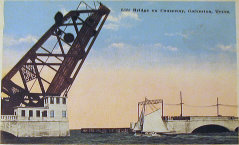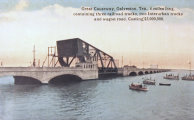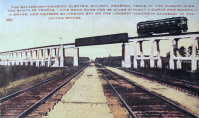Texas Railroad History - Towers 96, 97 and 98 -
the Galveston Island Causeway
Three Interlockers
Along the Galveston Island Causeway

Above: Railroad executive John
W. Barriger III was northbound from Galveston Island when he snapped this
photo from the rear platform of his private railcar, most likely in the mid
1930s. His camera impulse was spurred by Tower 96, the "Island" side
interlocking tower for the Galveston Island Causeway. Barriger is looking
southeast toward Galveston as his train has just left dry land and ventured onto the
causeway for the trip to the mainland. Barriger's train is on one of the two
"steam railroad" tracks on the causeway; the other is the
track to his immediate right. Both were shared by the steam railroads serving
Galveston: the Gulf, Colorado & Santa Fe Railway, the Texas & New Orleans (T&NO)
Railroad owned by Southern Pacific, and the Galveston, Houston & Henderson (GH&H)
Railroad. The GH&H was owned by the Missouri - Kansas - Texas (MKT) Railroad but its
tracks were shared with the International - Great Northern (I-GN) Railroad. The two tracks
farther to the right are a main track and
a short passing track of the interurban Galveston Houston Electric (GHE) Railway;
note its electrified catenary.
Below: Having just passed over the railroad bridge at the
center of the causeway, Barriger's camera impulse is triggered by Tower 97, the interlocking tower to
the right of the "Welcome" sign. Tower 97 controlled
the raising and lowering of the drawbridge, de-conflicting railroad and maritime
traffic. The
causeway's vehicle roadway is behind the barrier wall to the right; the automobile
visible on the GHE tracks is "driving around" Tower 97. (photos courtesy John W. Barriger III National Railroad
Library)
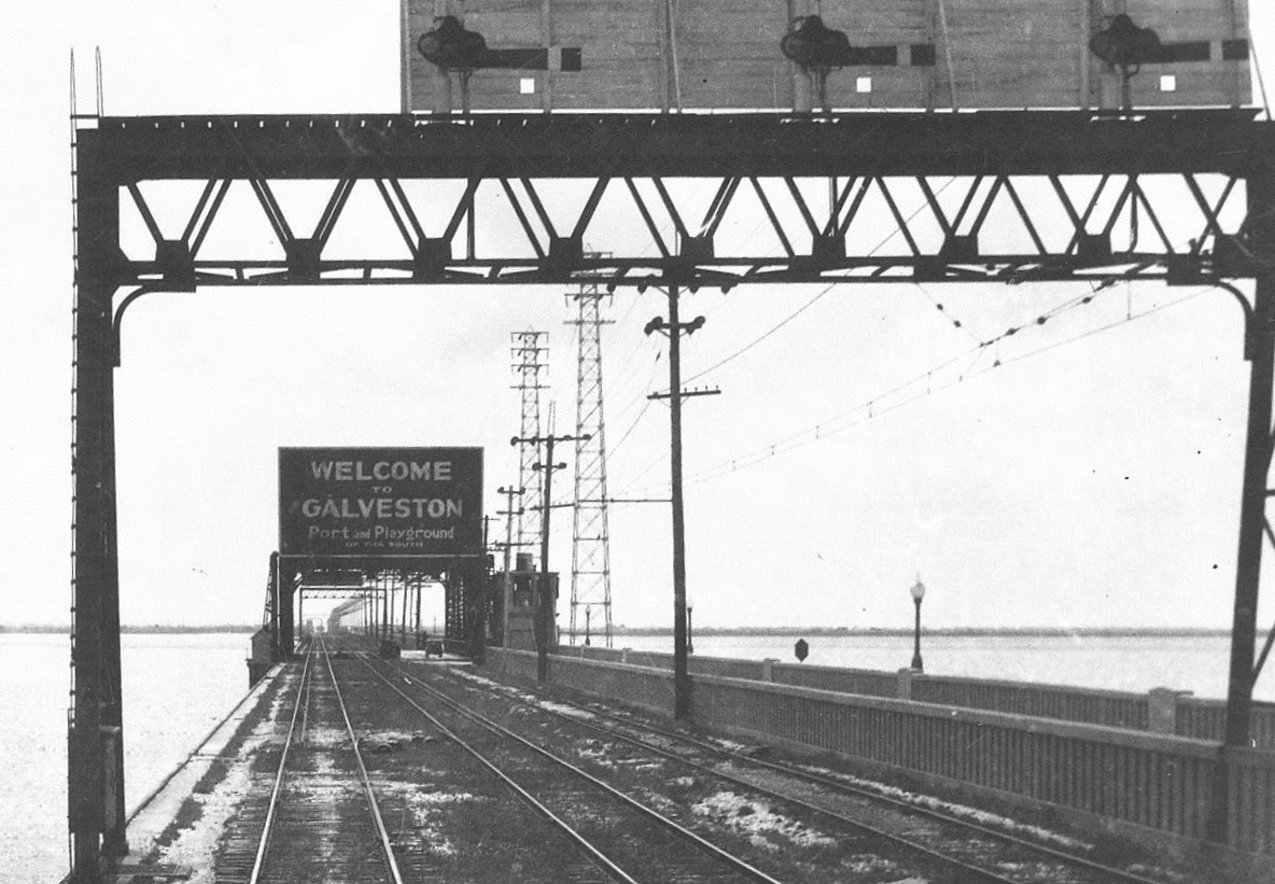
Below: Heading
the opposite direction (toward Galveston Island) on a
different trip, Barriger took this photo as his private railcar passed Tower 98,
the "mainland" tower at Virginia Point. The view is to the northwest and the
track to Barriger's left is the GHE with overhead electrification. The vehicle
roadway is farther left.
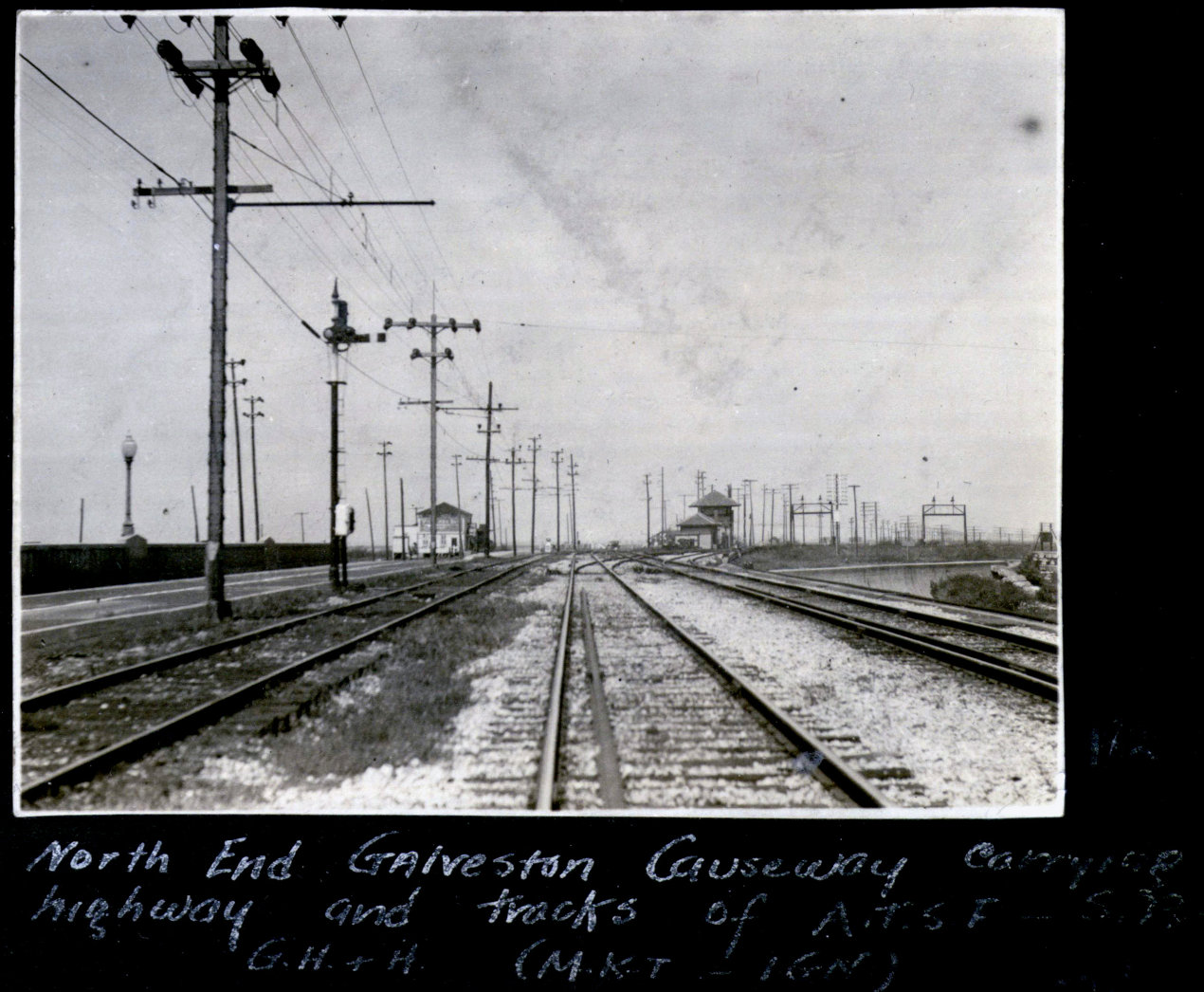
Galveston Island was a major port and commercial center in 19th century Texas,
so it is not surprising that railroads sought to provide service to the island.
The first railroad bridge was completed in 1860, owned by the Galveston, Houston
& Henderson (GH&H) Railroad. The GH&H bridge was two miles long,
departing the mainland at Virginia Point. By 1873, it had become apparent to
Galveston civic and commercial leaders that they needed a second railroad onto
the island, preferably one that did not pass through Houston.
For a variety of reasons (including yellow fever
quarantines against Galveston Island), freight bound for
Galveston by way of connection to the GH&H at Houston
did not always reach Galveston. Sometimes it was off-loaded at Houston and
shipped by barge down Buffalo Bayou to Galveston Bay to be loaded directly onto
ships, bypassing the Galveston wharves. To be fair, Houston shippers were trying
to overcome restrictive policies practiced by the Galveston Wharf Company that
favored Galveston's shippers over Houston's.
As S. G. Reed explained in
his reference tome A History of the Texas Railroads
(St. Clair Publishing, 1941), Galveston's citizens were certain that Houston
was...
"...inspired less by fear of the
plague than by a desire to hamper Galveston trade, as the quarantines were
established with regularity every fall when cotton was moving and trade was
best. So the Galveston people in 1873 decided to build a railroad into the
interior which would not pass through Houston."
Galveston's desire to have a railroad that
bypassed Houston led to the founding of the Gulf, Colorado & Santa Fe (GC&SF)
Railway. With a new bridge over Galveston Bay, Santa Fe construction reached
Arcola in 1877 and Richmond in 1879 (where Santa
Fe founded the adjacent town of Rosenberg.) By 1887, the
GC&SF had become part of the much larger Atchison, Topeka and Santa Fe
(AT&SF) Railway,
strengthening Galveston as a major commercial port.
After multiple corporate restructurings, the GH&H
became owned by the Missouri, Kansas & Texas (MK&T, commonly called
"the Katy") Railroad under the control of
rail baron Jay Gould. The Katy did not have tracks as far south as Houston,
so Gould leased the GH&H in 1883 to another railroad he controlled, the International
&
Great Northern (I&GN.) After Gould lost control of the Katy in 1890, the
newly
independent Katy restarted construction to Houston,
arriving in 1895.
The Katy demanded termination of the GH&H lease but the I&GN (still controlled
by the Gould family) refused. After lengthy litigation, the Katy regained
possession of the GH&H but the I&GN was granted permanent and unlimited
trackage rights by the court.
In the 1880s, Southern Pacific (SP) began to expand aggressively into Texas as their line
from California to Houston was completed. A significant part of its construction
was accomplished through arrangements with (and
a financial interest in) the Galveston, Harrisburg & San Antonio (GH&SA) Railway.
The GH&SA ran west from Harrisburg to
San Antonio and beyond, and it was soon acquired
by SP. What SP did not have was a bridge onto
Galveston Island. A third railroad bridge onto the island was not built until
1896, by the Galveston, La Porte and Houston Railway. GH&SA made arrangements to
use the new bridge, but this didn't last long -- the bridge was wiped out by
the massive hurricane of 1900. Only the GC&SF bridge survived that storm and it proved to be a critical
asset in the rebuilding of Galveston.
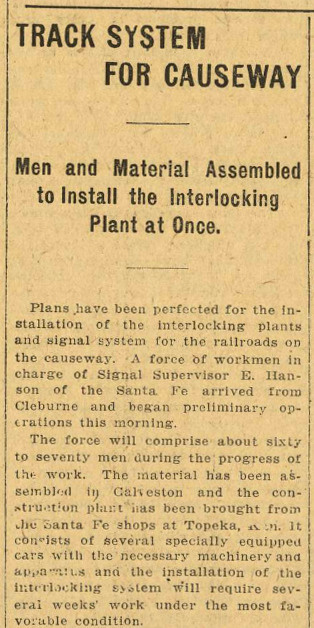 |
On May 12, 1912, a two-mile reinforced
concrete
causeway opened between Galveston Island and Virginia Point providing two tracks for
steam railroads, a track for the Galveston Houston Electric (GHE) Railway
(an electrified interurban), and a roadway for vehicles. Since the
causeway tracks were shared by multiple railroad companies, interlocking
towers had to be located at each end of the causeway to manage access to
the bridge. And because the causeway was not significantly elevated
above the surface of the waterway, a drawbridge section was incorporated
into the causeway to enable maritime traffic to pass. This required an
additional interlocker on the bridge to manage the controls and approach
signals, and to communicate with maritime traffic regarding the bridge
position. The three towers along the causeway were numbered 96
("Island"), 97 ("Lift Bridge") and 98 ("Virginia Point") by the Railroad
Commission of Texas (RCT.)
Left: The Galveston
Tribune of March 28, 1912 reported
that the installation of the interlocking plants and associated signals
for the causeway would begin promptly.
Right Top: The
Galveston Tribune of September 13,
1912 noted that RCT Engineer Parker had returned to Austin from
Galveston where he had been
inspecting the causeway's complex interlocking system. Tower 96's
commissioning date, September 6, 1912, suggests that this inspection was
accomplished during Parker's visit. Full operation required all
three towers to be commissioned, which did not occur until mid October.
Right Bottom: The
Galveston Tribune of October
23, 1912 reported that the interlocking system for the entire causeway
became operational earlier that day.
In 1915, another
massive hurricane caused severe damage to the causeway. During the storm, fourteen passengers on a stalled interurban
train escaped to the Causeway Hotel at Virginia Point, joining 36 people
that were already inside. The Galveston Tribune
of August 20, 1915, reported that these 50 people sought final refuge in
Tower 98...
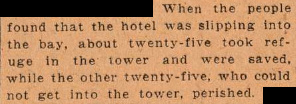
The causeway underwent major repairs with
priority given to restoring rail service, which took about a month.
|
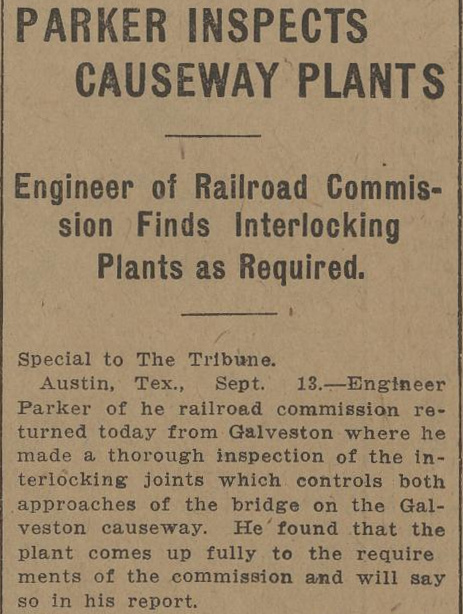
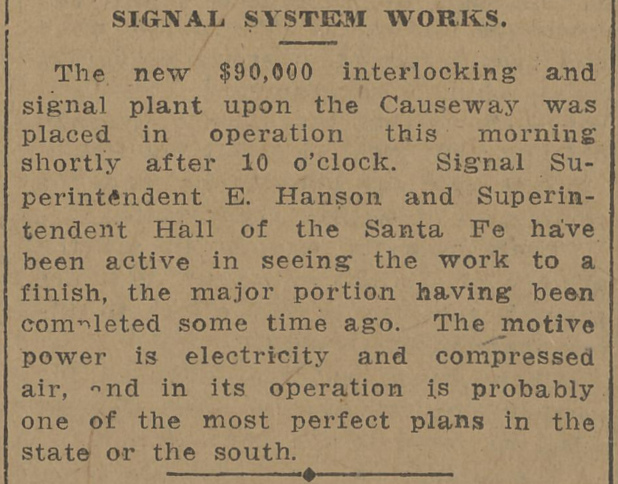 |
The causeway's construction had begun soon after the
contract was awarded on July 5, 1909. A parade celebrating the opening of the
causeway to vehicular traffic was held May 12, 1912. Among the parade entrants
were 23 cars piloted by members of the Houston Automobile Dealers Association,
which anticipated brisk business for new customers able to drive their purchases
home to Galveston.

Above: This image snippet from
a table of active interlockers published by RCT
at the end of 1916 shows that the three causeway towers were commissioned in September and October, 1912. They
were each listed with the same four railroads responsible for sharing recurring
operation and maintenance (O&M) expenses. The GC&SF is listed first because it
was the railroad initially responsible for O&M, a duty that periodically rotated
among the steam railroads. [Beginning with the 1916 list, the first named
railroad for each tower was responsible for O&M.] The "Interurban" (GHE) was dropped from the
list beginning with the 1924 RCT Annual Report and there was a corresponding
decrease in the number of functions listed for each of the interlockers. Since
the GHE remained in service until 1936, the reason for this change is unclear.
The list shows Towers 96, 97 and 98 having 67, 34 and 71 functions. Although the towers were
commissioned in the latter part of 1912, they did not appear in RCT's annual
list of active interlockers until the end of 1914.

Above: All three towers are
marked (but not labeled) on this graphic, which also identifies the two steam lines
and the single electric line on the Galveston Island Causeway. The tower at the
bridge is Tower 97; Tower
96 (Island) and Tower 98 (Virginia Point) are also depicted. The diagram
appeared in Vol. 21 (1928) of
Railway Signaling and Communications
in an article about the effort to consolidate Towers 96, 97 and 98 into a single
interlocking system. The work was done during a period commencing January, 1927
when Santa Fe was responsible for operating and maintaining the interlockers.
The article noted that these responsibilities rotated among the participating
railroads every five years. As part of its assessment of the feasibility of
consolidation, Santa Fe had determined that on average, the causeway was seeing
50 steam and 45 electric train movements per day, and that a maximum of 75 steam
and 60 electric movements had been observed in a single day.
The span of
interlocking control across the three towers included signals as far as 5.5 miles apart. The
incorporation of train detector circuits was a technology breakthrough that allowed tower operators to control signals
and switches for trains they could not see. This led to the design of an
illuminated track diagram (2 feet high by 23 feet long!) that showed precise
locations of all trains operating within the interlocking boundaries. Choosing to base all of the plants at
Tower 97 minimized the number of wires that needed to be carried in a new
submarine cable under the channel, but it required relocating the Tower 96 and
Tower 98 interlocking plants to Tower 97. All three interlockers used
electro-pneumatic actions to move switches and signals. Since this required
compressed air, Towers 96 and 98 were left in place to house air compressors, relays and other
electronics. The consolidation reduced operating expenses by approximately
$14,000 per year. The article also explains that the existing Tower 97 structure
had to be enlarged to house all of the new equipment.
The railroads that served Galveston were gradually
acquired and merged into larger rail systems. Missouri Pacific (MP) acquired the
I-GN in 1925 and fully merged it in 1956. Union Pacific (UP) acquired MP in 1982
and then acquired the Katy in 1988, merging it into MP. This put the GH&H tracks
completely under MP control. The GH&SA was acquired by SP in the 1880s; in 1934
it was merged into SP's operating railroad for Texas and Louisiana lines, the
Texas & New Orleans (T&NO) Railroad. In 1961, the T&NO was fully merged into SP.
The GC&SF became fully merged into its parent company AT&SF in 1965. In 1995, AT&SF merged with Burlington
Northern to form Burlington Northern Santa Fe (BNSF). The GHE ceased operating
in 1936 and much
of its right-of-way from Houston to Virginia Point now hosts utilities and power lines.
Tower 96 (Island - Causeway)
RCT lists the location of Tower 96 as Island - Causeway. "Island" was the name of
a small community on the peninsula of land between Offatts Bayou and Galveston
Bay. Island had its own school and retained a separate identity until it was
consumed by growth of the City of Galveston. Tower 96 was built on the peninsula
at Island and was the first of the three causeway interlockers authorized for service,
commissioned on September 6, 1912 with a 67-function electrical interlocker. The
1931 RCT Annual Report lists Tower 96 as no
longer in service, reported as "consolidated with No. 97", due to the
1927 interlocking plant relocations.
At the time of its decommissioning, the number of interlocker functions had
dropped to 61.
The Tower 96 structure remained
standing to house air compressors and other electronics for decades. It was abandoned and remained derelict for
many years, but has since been razed.
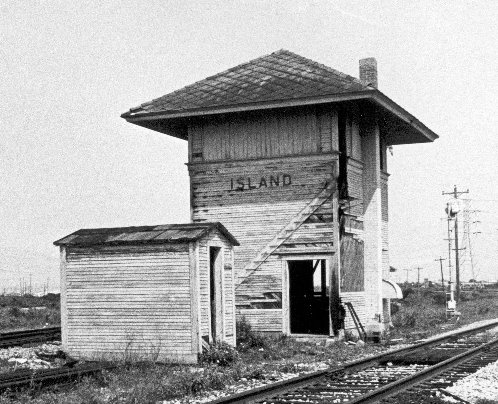
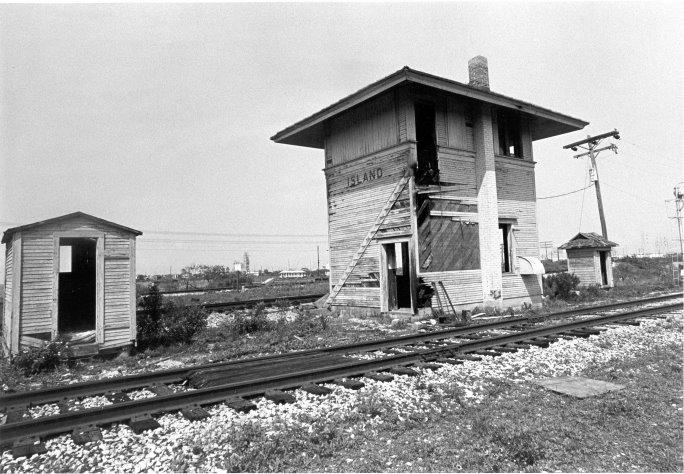
Above: Two photos of the abandoned Tower 96 showing the north side (left) and northwest
corner (right) of the tower. Note the small phone shanty located behind
(south of) the tower.
(Photos from the Galveston Railroad Museum collection)
Tower 97 (Lift Bridge - Causeway)
Tower 97's location was identified in RCT reports as Lift Bridge - Causeway,
authorized for operation on October 23, 1912 as a 34-function electrical
interlocker. It was the last of the three causeway interlockers to begin
service, located adjacent to the drawbridge span in the middle of the causeway.
It provided the safety system for the bridge by arbitrating access between the
railroads and maritime traffic. The original Tower 97 structure was replaced with a modern building to control the drawbridge, signal lights and
switches on both approaches. As discussed above, the Tower 96 and 98
interlockers were relocated to Tower 97 in 1928 which required expanding the
upper floor of the facility. The retirement of Tower 17
in Rosenberg in 2004 left Tower 97 as the last manned interlocking tower in Texas.
The original lift bridge was replaced in 1987 with a bascule bridge that
pivoted from the island side, not the mainland side as the original had. To widen the waterway, the causeway needed to be shortened from the
middle; this was easier to accomplish by removing a portion of the causeway
on the island side since it did not have the existing bridge pivot assembly and
tower structures that sat on the mainland side. In 2012, the 1987 bascule bridge was replaced by a much longer
vertical lift bridge to satisfy Coast Guard
Intra-Coastal Waterway safety requirements. Stuart L. Schroeder reports...
"At the time of my retirement in November 2016, there was still an operator
at the Galveston lift bridge but the BNSF Galveston Subdivision train
dispatcher in Spring had a role in the operation of the bridge." There
is only one railroad track across the causeway, but the timing of when the other
tracks were removed is undetermined.
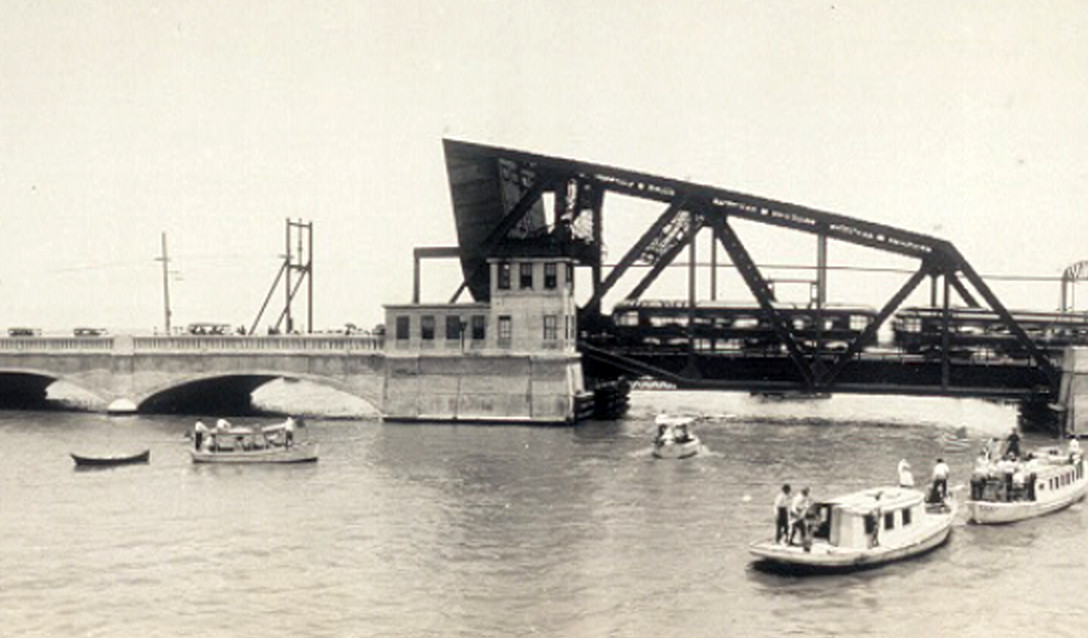

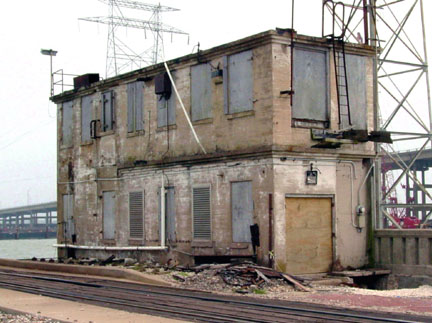
Above Left: This Library of
Congress photo was possibly taken at the commissioning of Tower 97. With boats,
rail cars and automobiles, something special appears to be happening. At the
time, the upper floor of the Tower 97
building housed the tower structure and nothing else. Note that the counterweight of the drawbridge
is adjacent to the tower, which is on the mainland side of the waterway. This
changed when the drawbridge was replaced.
Above Center: Don Harper took this photo that shows both Tower 97 structures: the original
(left) and the new one (right). The original building had been modified so that the upper floor
occupied the full extent of the building. This was accomplished during the 1928
consolidation of all three interlocking machines into Tower 97 so that Towers 96
and 98 were no longer manned. The new tower building was constructed when the
drawbridge was replaced by a larger bascule bridge in 1987. Like the prior
bridge, the counterweight of the new bridge is adjacent to the tower, but both
are now on the island side of the waterway.
Above Right: Daniel Walford
took this close-up of the abandoned structure.
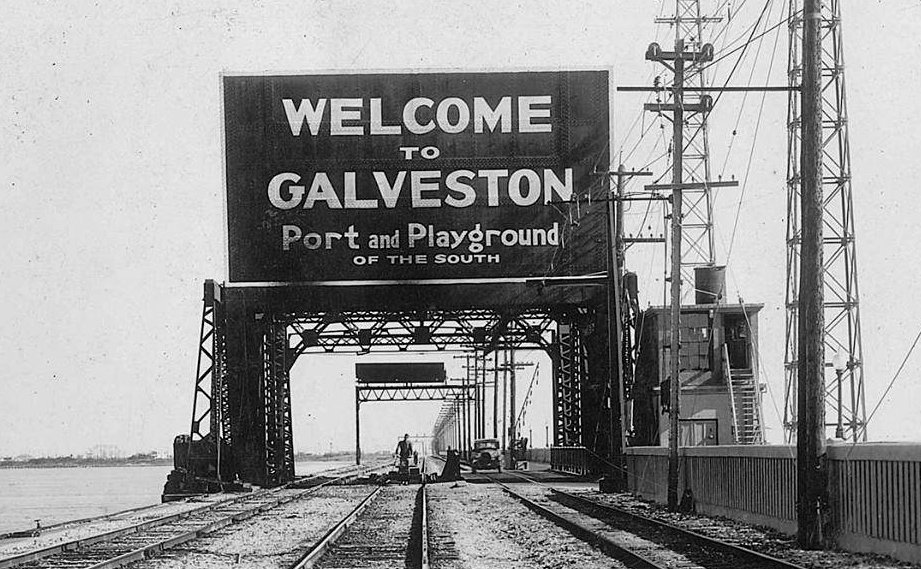
Above: The Galveston tourism
bureau wanted to make sure visitors knew they were welcome in Galveston! Note
that the vehicle approaching the camera has been routed onto the GHE tracks. The
roadway was on the other side of the wall at right, so vehciles had to go around Tower 97
by briefly driving on pavement in which the GHE tracks were embedded. (Galveston Historical Foundation photo)
On 9/3/2002, Don Harper emailed
a description of a visit he made to Tower 97:
"I watched while signals and switches were aligned several times.
All pushbutton operation. ... The tower is noisy. There are at least 3 radios in there, one
BNSF, one UP, and one on channel 16 for boat traffic. The operator
was kept hopping much of the time I was there. Several vessels
passed through, the Gulfliner went through 3 times and a BNSF
outbound passed by. ... An interesting sideline: the tower operator records the names
of tow boats passing the tower, what their load is, and the direction
they are heading ... at the request of the Coast Guard. If a
vessel is reported missing or sinking, the Coast Guard has a general frame
of reference as to where the vessel might be."
1981 Barge Collision
In a Railspot post dated February
22, 2017, Rollin Bredenberg recounted this story...
"SP operated the bridge until the infamous incident in
1981 when the SP operator told a northbound tow of barges to proceed into the
old bascule structure. The tow boat captain was running in dense fog and asked
her if the bridge was open. She said "no, but I'll raise it up for you." Turns
out she had been doing a good bit of weed smoking that night, and instead of
raising the bridge she went downstairs to the rest room. When the captain saw
that the bridge was still down (10 min. after the initial radio conversation) he
immediately sounded his horn in short rapid bursts, at which point the 24 year
old SP operator ran as fast as she could away from the control house. The
inevitable collision compromised the barges causing the butadiene to bleed.
After the initial explosions the product burned for over a day. The bascule
span was useless scrap metal. The incident did not affect SP greatly except for sulphur trains that could not get onto the island. ATSF, on the other hand, was
severely impacted and incensed that they were separated from the island for IIRC
three weeks. ATSF asked that SP allow ATSF to take over control and maintenance
of the bridge. SP gladly agreed and that is why BNSF now controls the bridge.
There were no injuries resulting from this accident. The operator did not show
up for her formal investigation and her short railroad career ended that night."
Tower 98 (Virginia Point - Causeway)
Tower 98 was a 71-function electric-pneumatic interlocker located at Virginia
Point on the mainland end of the causeway. It was commissioned for operation on
October 14, 1912 and decommissioned in 1928 when its interlocking plant was
relocated to Tower 97. Virginia Point dates back to at least 1840 when a
community was organized at the site of a ferry operation. Virginia Point was
intended to become the founding site of Texas City, but that town was laid out
farther north after the hurricane of 1900. Virginia Point expanded as a result
of the completion of the new causeway in 1912, but the community was wiped out
again by a major hurricane in 1915. Some portions of the community were rebuilt,
but it remained underdeveloped and was annexed by Texas City in 1952. Despite
decommissioning in 1929, Tower 98 remained intact to house air compressors and
other electronics for the consolidated interlocking system. It eventually was
abandoned and remained standing into the 1980s.
 |
Left:
Northwest corner of Tower 98 (Galveston Railroad Museum collection)
Right: Southwest
corner of Tower 98 (Tom Kline, 1978) |
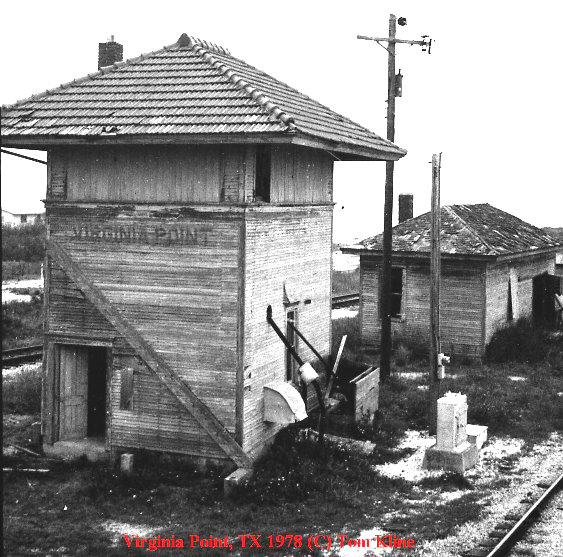 |
A highway bridge built onto the island in 1938 carried lanes in both
directions and incorporated a drawbridge. This allowed vehicular traffic to be
removed from the 1912 causeway. By the mid-1950s, the 1938 bridge was inadequate
for the higher traffic levels being experienced, so a new bridge was built that was high enough to not
require a drawbridge. Traffic was relocated to this new bridge in 1961 while the
old bridge was substantially modified to raise its height so that its drawbridge
could be eliminated. When it reopened in 1964, the two bridges were used to
carry traffic in opposite directions. In 2003, construction began on new bridges for Interstate 45 traffic to replace the older ones. The new
northbound bridge opened in 2005; the southbound bridge opened in 2008. This new
I-45 causeway was rededicated as the George and Cynthia Mitchell
Memorial Causeway in 2016.
Additional Tower 97 and Causeway Photos by Don Harper (click to enlarge)

lift bridge counter-weight |

old
(left) and new (right) towers |
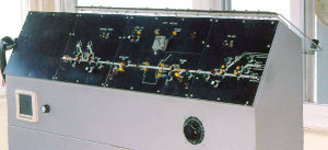 plant
panel and bridge controls plant
panel and bridge controls |
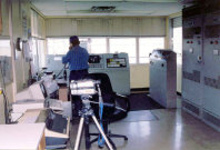
interior view |
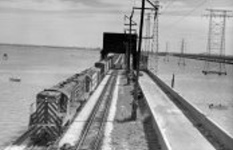
causeway, November 1957 |
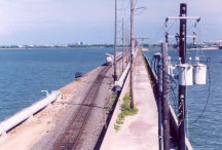
Gulfliner northbound |
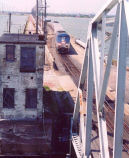
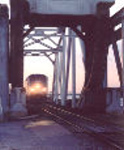
Gulfliner southbound past old tower |
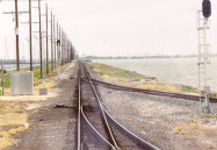
merging onto causeway (cab view) |
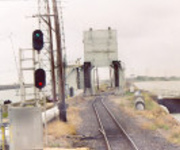
lift bridge approach (cab view) |
|
Images from the Post Card Collection of
Bruce Blalock (click to enlarge)
Additional Photos of Tower 96 (click to enlarge)
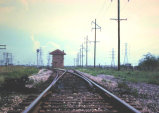
Bob Nicholson, Sept 1970 |
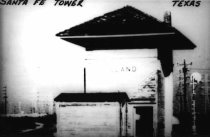
Carl Codney
collection, undated |
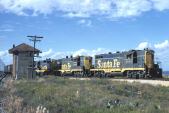
Ralph Back, Nov. 14, 1971 |

east
side, Galveston RR Museum coll. |

north side, Galveston RR Museum coll. |
Additional Tower 98 Photos from the Galveston
Railroad Museum (click to enlarge)
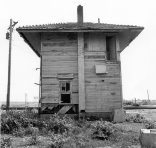
east side |
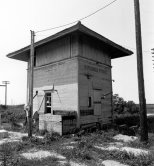
southwest corner |
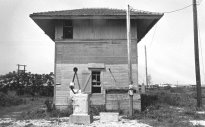
west side |
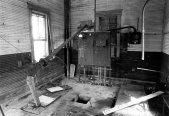
interior |
Additional Photos of Tower 98 from the Tom Kline collection (click to
enlarge)
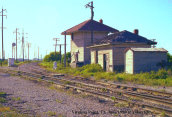
GC&SF/GH&H split |
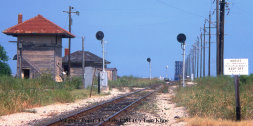
west approach |
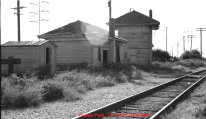
east approach |
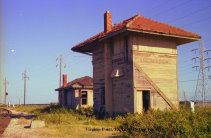
north side |
Additional Photos of Tower 98 by Mark Nerren in 1980
(click to enlarge)

west side |
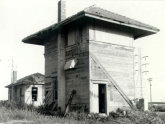
northeast corner |
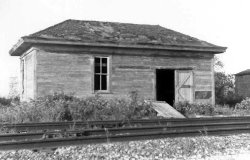
section house |
Images from the Steven M. Baron Collection (click to
enlarge)
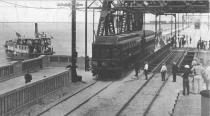
Interurban crossing lift
bridge |

Interurban viaduct |
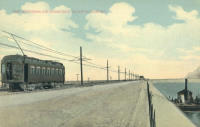
Interurban on causeway |
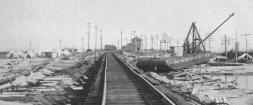
Tower 98 after the Hurricane of 1915 |
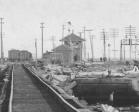
magnified view |
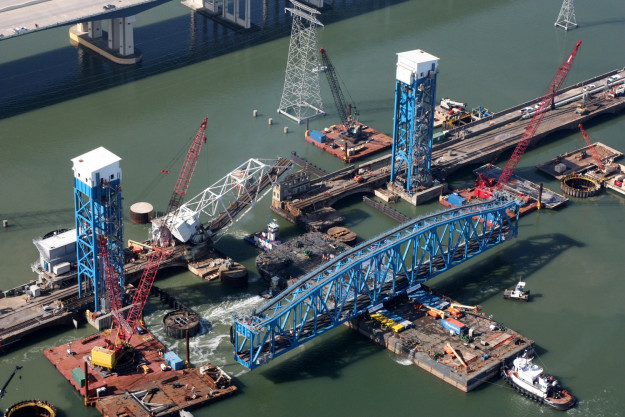
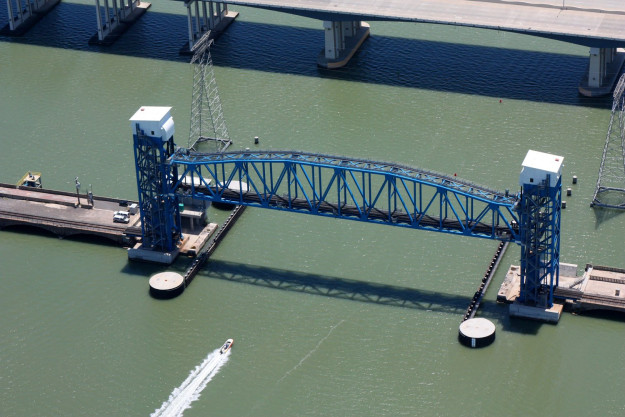
Above: The span of the 1987
bascule bridge limited maritime traffic to less than 100 ft. width, a problem
that the U.S. Coast Guard had long identified. In the early 2000s, planning for
a new vertical lift bridge to replace the bascule bridge was undertaken to
triple the width of the passageway. The new bridge was installed in 2012. The
freeway visible in the upper part of these photos is the Interstate 45 causeway
that opened in 2005-2008. (photos provided by Brasfield & Gorrie)
Brasfield & Gorrie is a construction company that led a
joint venture team to build and install the new vertical lift bridge. They
explain that the ...
"...bridge is a 382-foot main lift
span that rises 80 feet to allow Intercoastal waterway traffic on Galveston Bay
to pass under the BNSF Railroad. ... Challenges of this project included the
placement of all of the mass concrete for the tower foundations. Each pier has
approximately 5,000 cubic yards of concrete that were placed in varying lifts,
ranging from 700 to 1,300 cubic yards. ... Perhaps the biggest challenge was the
float-out of the old bascule bridge and float-in of the main span. This
float-out/float-in procedure had to be completed within a 72-hour marine channel
shutdown, with only a 12-hour window to close the bridge from rail traffic. The
main span was built at the port, placed on barges, and then floated into place,
with only eight inches of clearance between the towers and new span.



























